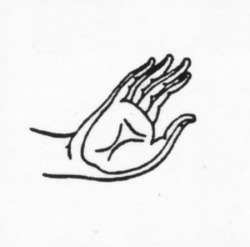Abhaya Mudra (Gesture of Fearlessness)
Abhaya in Sanskrit means fearlessness, and the abhaya mudra symbolizes protection, peace, and the dispelling of fear. The gesture is made with the right hand raised to shoulder height, arm bent, and palm facing outward.
The gesture is an ancient one, demonstrating that the hand is empty of weapons and thus indicating friendship and peace. To western eyes, it looks like the gesture meaning "stop." In both cases, the gesture implies fearlessness before a potential enemy.
In Buddhism, the gesture is a symbol of the fearlessness—and thus the spiritual power—of the Buddha or bodhisattva who makes it.
According to Buddhist tradition, the historical Buddha made this gesture immediately after gaining enlightenment. And later, when the historical Buddha was about to be attacked by an angry elephant, he held up his hand in the fearlessness gesture and immediately calmed it.
The gesture of fearlessness is is only seen on Buddhas or bodhisattvas and appears most commonly in standing images. In Thailand and Laos, the abhaya mudra is seen on the walking Buddha (also called 'the Buddha placing his footprint'), a posture unique to that region.
When the right hand is in the abhaya mudra, the left hand usually hangs loosely at the side of the body or makes the varada mudra, or gift-giving gesture. In some SE Asian Buddha images, both hands are held in the abhaya mudra.
In Gandhara art, this mudra was sometimes used to indicate the action of preaching. This is also the case in China where it is very commonly found in images of the Buddha, mainly in the Wei and Sui eras (4th to 7th centuries).
The abhaya mudra is the gesture of the fifth Dhyani Buddha, Amoghasiddhi. By meditating on him, Amoghasiddhi helps in overcoming the delusion of jealousy and transforming it into the wisdom of accomplishment. Since jealousy can be seen as a type of fear, the gesture of fearlessness is appropriate for this Buddha.
